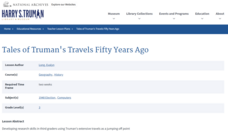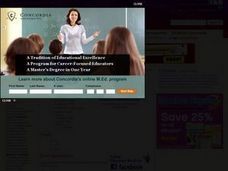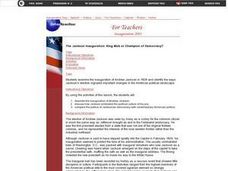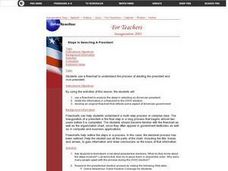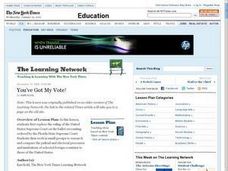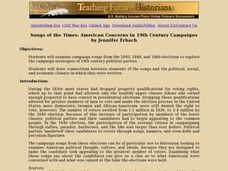Curated OER
Tales of Truman's Travels Fifty Years Ago
Fourth graders study President Truman and the Whistlestop Campaign. For this US history activity, 4th graders complete a KWL about President Truman and write letters to stops on Truman's Whistlestop Campaign. Students create a...
Curated OER
Getting to Know the Candidates: Analyzing Their Campaign Ads
Students examine the role of advertising in presidential campaigns. They analyze one candidate's advertising campaign ads for elements such as major issues, positivity, negativity, facts, and opinions.
Curated OER
Using Current Events to Understand Elections
Eleventh graders explore the the major phases of the electoral process for president. In this US Government lesson, 11th graders compare and contrast the delegate system of nomination and the electoral college.
Curated OER
United States Presidents
In this presidential worksheet, students color a picture of a United States President. There are pictures of each president from George Washington through George W. Bush. Each picture takes up one page. The name and dates of service...
Facing History and Ourselves
Confirmation and Other Biases
As the investigation into the reporting of the events in Ferguson, Missouri, continues, class members consider how bias influences perception, how the tendency is to collect evidence that supports preconceived notions. The big idea...
Street Law
The Challenge of Selecting an Ideal Supreme Court Nominee
Nearly every president has had the opportunity to name a nominee to the United States Supreme Court. But what makes someone an ideal candidate to become a Supreme Court justice? High schoolers test their prior knowledge about the...
PBS
The Big Picture-Economic Security in the Country and your Community
High schoolers explore economic security at the local and national level during the time period preceding the 2008 presidential election. They fill out surveys on their thoughts and concerns regarding the US economy, and watch...
Curated OER
TV ATTACK ADS AND THE VOTER
High schoolers read about the history of negative political advertisements in U.S. elections. In this politics lesson, students view several ads for opposing candidates and analyze and discuss the content. High schoolers write scripts...
Curated OER
The Jackson Inauguration: King Mob or Champion of Democracy?
Students examine and describe Andrew Jackson's 1828 inauguration, identify ways Jackson's election signaled important changes in American political landscape, discuss how Jackson embodied political culture of his era, and compare...
School Improvement in Maryland
Demographic Investigation
What are the factors that influence voting patterns? How do these factors influence government funding? Is participation the squeaky wheel gets the grease? Class members interpret graphs and analyze trends to determine what...
Curated OER
he Inauguration and the Media
Students read, review, and write about the presidential inauguration as it appears in the media. They use local local and national newspapers to gain information about the inauguration. Students develop their own editorial on the...
Curated OER
Magnetic Polls
Students explore the New Hampshire primaries and the polling process by analyzing polling information, examining the effects of polls, and creating graphs that represent polling data.
Curated OER
Campaign 2004: Classroom Electorate
High schoolers role play as political analysts first forecasting the electoral college vote in a presidential election and then, following the results of the actual count. They study the role of swing states, and why political...
Curated OER
The U.S. Recognition of the State of Israel
High schoolers research the political aspects of the U.S. position in the Middle East, considering, for example, Truman's position in view of the 1948 presidential election. They examine a telegram sent by the Secretary of State, George...
Curated OER
My Country, My Country: To Vote or Not to Vote
Students view a film about elections in Iraq. They examine the story of a doctor and his decisions to vote. They work together to complete a worksheet about voter turnout.
Curated OER
Progression of Political Movements
High schoolers examine the various political parties throughout history. In groups, they are given documents identifying the platforms of the parties in the 1868 election. To end the lesson, they share their information with the class...
Curated OER
Steps In Selecting A President
Learners follow a flowchart that describes the process of electing the American president and vice-president. They create a flowchart that explains some aspect of the US government.
Curated OER
You've Got My Vote!
Students explore the ruling of the US Supreme Court on the ballot recounting ordered by the Florida State Supreme Court. They work in small groups to research and compare the judicial and electoral processes.
Curated OER
Civil War and Reconstruction
Fourth graders investigate the Civil War by researching the state of Virginia. In this US History lesson, 4th graders identify Abraham Lincoln, James Chestnut and Fort Sumter, and discuss their roles in the start of the Civil...
Curated OER
Presidential Race
Students explain the way in which a candidate wins an electorial race and the number of votes necessary to win in the electoral college through movement.
Curated OER
California Primary 2000
Students explore the open primary system and the candidates that appeared on the ballot in California's Presidential Primary in 2000. A variety of issues and sites are explored and form the focus of this lesson.
Curated OER
Songs of the Times: American Concerns in 19th Century Campaigns
Students examine campaign songs from the 1840, 1848, and 1860 elections to explore the campaign strategies of 19th century political parties.
Illustrative Mathematics
Electoral College
A cross-curricular resource that takes the electoral votes and allows your learners to organize and analyze the data. Young voters can determine which states are more influential and interpret the dotplot provided for more data....
Curated OER
The U.S. Constitution: Practical Application of the Amendments
Young scholars create their own HyperStudio cards which include scanned images of at least one member (designated reader) of each group. They add the text of a predetermined amendment. The designated reader then reads the selected...


